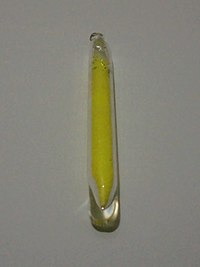Zinc acetate is a salt with the formula Zn(O2CCH3)2, which commonly occurs as the dihydrate Zn(O2CCH3)2(H2O)2. Both the hydrate and the anhydrous forms are colorless solids that are commonly used in chemical synthesis and as dietary supplements. Zinc acetates are prepared by the action of acetic acid on zinc carbonate or zinc metal. When used as a food additive, it has the E number E650.
Basic properties and structures

In anhydrous zinc acetate the zinc is coordinated to four oxygen atoms to give a tetrahedral environment, these tetrahedral polyhedra are then interconnected by acetate ligands to give a range of polymeric structures. In contrast, most metal diacetates feature metals in octahedral coordination with bidentate acetate groups.
In zinc acetate dihydrate the zinc is octahedral, wherein both acetate groups are bidentate.
Basic zinc acetate
Heating Zn(CH3CO2)2 in a vacuum results in a loss of acetic anhydride, leaving a residue of basic zinc acetate, with the formula Zn4O(CH3CO2)6. This cluster compound has the tetrahedral structure shown below. This species closely resembles the corresponding beryllium compound, although it is slightly expanded with Zn-O distances ~1.97 vs ~1.63 Ã… for Be4O(OAc)6.
Applications

Dietary and medicinal applications
Zinc acetate has been used in lozenges for treating the common cold. Pooling the results of three high dose zinc acetate trials indicates an average 42% reduction in the duration of colds (see figure).
Zinc acetate is a particularly useful salt in lozenges since acetate does not bind zinc, with the result that essentially all zinc from the lozenges is freely released.
Although zinc acetate lozenges appear to be able to shorten the duration of colds, some zinc lozenges may be more effective than others. Among the factors affecting the usefulness of a zinc lozenge are the total dose of zinc provided as well as the presence of substances like citric acid which may bind up much of the zinc that the lozenge is providing.
Zinc acetate can also be used to treat zinc deficiencies. As an oral daily supplement it is used to inhibit the body's absorption of copper as part of the treatment for Wilson's disease. Zinc acetate is also sold as an astringent in the form of an ointment, a topical lotion, or combined with an antibiotic such as erythromycin for the topical treatment of acne. It is commonly sold as a topical anti-itch ointment.
In chewing gum, zinc acetate is a breath freshener and plaque inhibitor.
Industrial applications
Industrial applications include wood preservation, manufacturing other zinc salts, polymers, manufacture of ethylene acetate, as a dye mordant, and analytical reagent. It is used in commercial nuclear power plants as a plating inhibitor on primary water piping.
See Also

- Basic beryllium acetate - isostructural
References
- ^ Clegg, W.; Little, I. R.; Straughan, B. P. (15 December 1986). "Monoclinic anhydrous zinc(II) acetate". Acta Crystallographica Section C Crystal Structure Communications 42 (12): 1701â€"1703. doi:10.1107/S010827018609087X.Â
- ^ He, Hongshan (15 November 2006). "A new monoclinic polymorph of anhydrous zinc acetate". Acta Crystallographica Section E Structure Reports Online 62 (12): m3291â€"m3292. doi:10.1107/S1600536806046678.Â
- ^ Capilla, A. V.; Aranda, R. A. (1979). "Anhydrous Zinc(II) Acetate (CH3-COO)2Zn". Crystal Structure Communications 8: 795â€"797.Â
- ^ van Niekerk, J. N.; Schoening, F. R. L.; Talbot, J. H. (10 September 1953). "The crystal structure of zinc acetate dihydrate, Zn(CH3COO)2.2H2O". Acta Crystallographica 6 (8): 720â€"723. doi:10.1107/S0365110X53002015.Â
- ^ Ishioka, T.; Murata, A.; Kitagawa, Y.; Nakamura, K. T. (15 August 1997). "Zinc(II) Acetate Dihydrate". Acta Crystallographica Section C Crystal Structure Communications 53 (8): 1029â€"1031. doi:10.1107/S0108270197004484.Â
- ^ Koyama, H.; Saito, Y. (1954). "The Crystal Structure of Zinc Oxyacetate, Zn4O(CH3COO)6". Bull. Chem. Soc. Japan 27 (2): 112â€"114. doi:10.1246/bcsj.27.112.Â
- ^ Hemilä, Harri (23 June 2011). "Zinc Lozenges May Shorten the Duration of Colds: A Systematic Review". The Open Respiratory Medicine Journal 5 (1): 51â€"58. doi:10.2174/1874306401105010051. PMC 3136969. PMID 21769305.Â
- ^ Eby, George A. "Zinc Lozenges: Cold Cure or Candy? Solution Chemistry Determinations". Bioscience Reports 24 (1): 23â€"39. doi:10.1023/B:BIRE.0000037754.71063.41.Â
- ^ Eby, George A. (Mar 2010). "Zinc lozenges as cure for the common cold â€" A review and hypothesis". Medical Hypotheses 74 (3): 482â€"492. doi:10.1016/j.mehy.2009.10.017. PMID 19906491.Â
- ^ Eby G (2009) Zinc Lozenges as a Common Cold Treatment
- ^ US 7087255Â
- ^ US 6592849Â
- ^ Giertsen E, Svatun B, Saxton A (February 1987). "Plaque inhibition by hexetidine and zinc". Scand J Dent Res 95 (1): 49â€"54. doi:10.1111/j.1600-0722.1987.tb01392.x. PMID 3470899.Â




0 komentar :
Posting Komentar